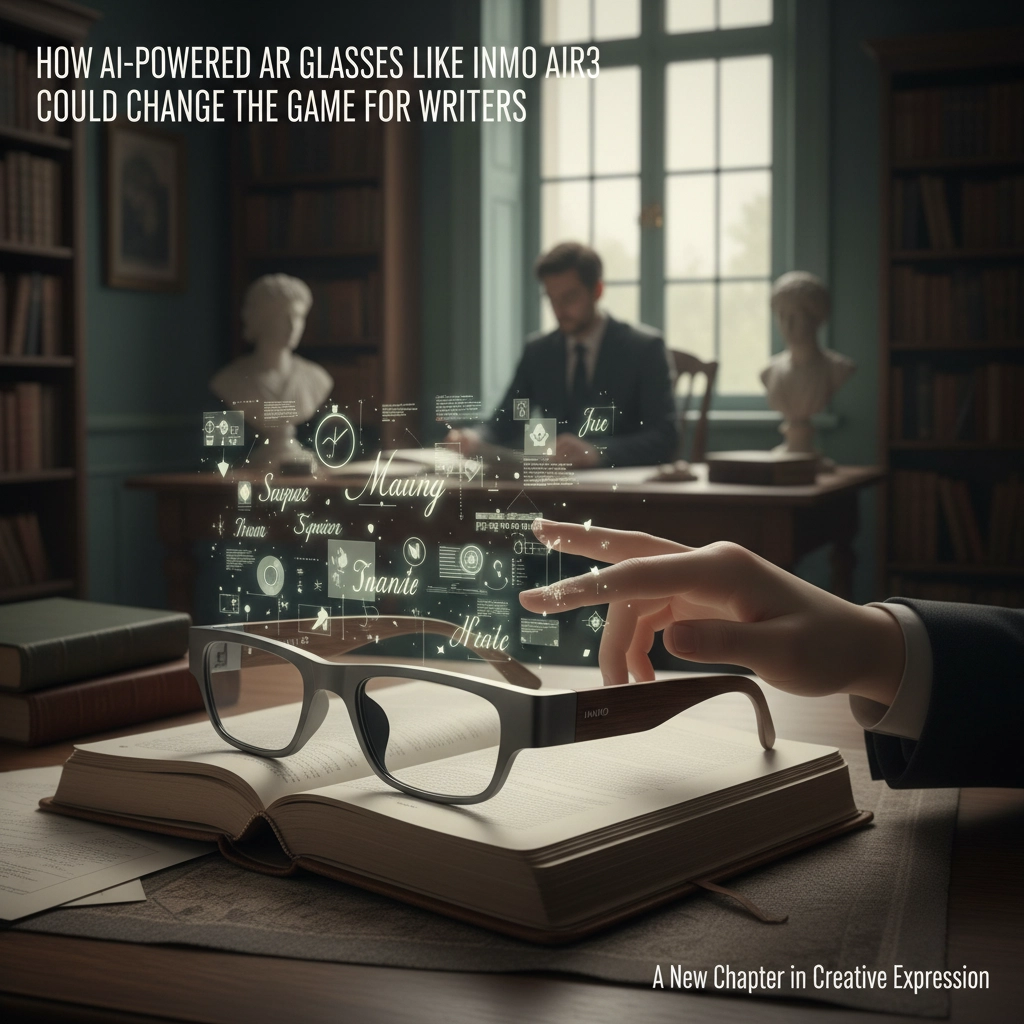How AI-powered AR glasses for writers like INMO Air3 Could Change the Game
- killianwolf
- Sep 22
- 6 min read

Imagine this: you're off to a writer's retreat in Florence. You arrive at the airport with just your clothes and a pair of INMO Air3 AI-powered AR glasses for writers. While you wait for your plane, you manage three writing sprints. You do not need to find a table or set up a laptop. You walk around the terminal, check emails, answer messages, then charge your glasses on the plane.
When you reach Florence, you toggle your translation app to move between Italian and English in real time. Teleprompt-style captions appear as locals speak, along with guided phrases to respond in Italian. Need to book train tickets or a car? The glasses use AR overlays to place directions and booking steps right in front of your eyes and guide you step by step. Navigation on the road happens through digital overlays. You do not juggle multiple devices or chargers. One pair of glasses handles everything on the go. And if you want to document your journey, you can even hands-free vlog your trip: recording everything you see and experience, all from your glasses, no phone or extra camera needed. Plus, you can make calls directly from your glasses, so you stay connected with friends, family, or colleagues while on the move, totally hands-free.
Picture this: you're sitting in a coffee shop, and instead of hunching over a tiny laptop screen, you have three massive virtual monitors floating in front of you. Your manuscript is on one screen, research notes on another, and a live AI writing assistant on the third. No phone, no tablet, no computer: just a lightweight pair of glasses that weighs less than your morning latte.
This isn't science fiction. It's happening right now with the INMO Air3, and it's about to flip the script on how writers work.
What Makes These AI-powered AR glasses for writers Different
The INMO Air3 isn't just another tech gadget trying to solve problems we don't have. These glasses pack serious horsepower into a frame that weighs just over 40 grams. We're talking about a Sony 0.44-inch Micro OLED display pushing 1920×1080 resolution: that's like having a 150-inch screen floating in your field of vision.
But here's where it gets wild: they've integrated ChatGPT, Whisper, and Perplexity directly into the glasses. Plus real-time translation for 41 languages and 93 regional dialects. And they run on their own IMOS 3.0 operating system designed specifically for AI and AR.

The best part? You can connect your smartphone's keyboard via Bluetooth, so you're not stuck typing in the air like you're conducting an invisible orchestra.
Virtual Monitors That Actually Make Sense for Writers
Let's talk about the three virtual monitors feature, because this is where things get interesting for writers. Instead of constantly minimizing and maximizing windows, you can spread your work across three separate virtual screens that exist in 3D space around you.
Imagine having your current chapter open on the center screen, your outline and character notes on the left, and your research materials on the right. You can physically turn your head to reference different information instead of playing digital hide-and-seek with browser tabs.
This spatial approach to writing could be a game-changer for complex projects like novels or research papers where you need to juggle multiple sources and documents. Your brain processes spatial information naturally, so organizing your work in 3D space feels more intuitive than traditional flat-screen workflows.
Your AI Writing Assistant Gets an Upgrade
Having ChatGPT, Whisper, and Perplexity built into your glasses means your AI writing assistant is always there, ready to help without interrupting your flow. Stuck on a word choice? Ask without looking away from your manuscript. Need to fact-check something? Get instant verification overlaid right in your vision.
The voice integration through Whisper means you can brainstorm out loud and have your ideas transcribed in real-time. This is huge for writers who think better when they talk through problems. You can pace around your office, work through plot issues verbally, and watch your thoughts appear as text in your virtual workspace.

The real magic happens when these AI tools work together. You could be writing a scene set in 1920s Paris, ask for historical context, get fact-checked information from Perplexity, and have ChatGPT help you refine the dialogue: all while never taking your eyes off your manuscript.
Breaking Down Language Barriers for Research
The real-time translation feature opens up research possibilities that most writers have never considered. You can read source materials in their original languages and view instant translations without losing the context that is often lost in pre-translated content.
Working on a historical novel? Read contemporary newspapers from the period in their original language. Writing about international culture? Access local blogs and social media for authentic voices and perspectives.
This feature could democratize global research for writers who previously felt limited by language barriers. The ability to access and understand content in 41 languages means your research pool just got exponentially larger.
Rethinking the Writer's Workflow
The INMO Air3 could reshape how writers approach their daily routine. Instead of being chained to a desk, you could write effectively from anywhere. The lightweight design means comfortable all-day wear, and the virtual workspace travels with you.
Picture starting your writing session at home with your full virtual setup, then heading to a quiet park while maintaining the same workspace configuration. Your three virtual monitors, AI assistant, and research materials move with you seamlessly.

The technology also supports what experts call "always-on creative companionship." Your AI assistant could suggest plot developments during your morning walk, help brainstorm character names while you're commuting, or provide writing prompts based on your environment and current project.
Real-World Applications That Matter
Check out this detailed review of the INMO Air3 in action: https://www.youtube.com/watch?v=_dBXAHvREPg. The reviewer demonstrates how the AR interface works in practice, and you can see how the virtual monitors and AI integration actually function in real-world conditions.
For memoir writers working with Legacy Collection Press, imagine interviewing family members while having your research notes and family tree visible in your peripheral vision. You could record the conversation through Whisper while making visual notes that appear to float beside your subject.
Fiction writers could benefit from having character sheets and world-building notes constantly accessible without breaking immersion. The spatial memory aspect means you'll remember where you "placed" different pieces of information in your virtual workspace.
The Technology Behind the Magic
The INMOS 3.0 operating system deserves special mention because it's specifically designed for AR and AI integration. This isn't just Android with AR features bolted on: it's built from the ground up to handle the complex interactions between artificial intelligence, augmented reality, and human creativity.
The magnesium-lithium alloy frame with 15-degree adaptive temples means comfort during long writing sessions. Soft-touch materials prevent the fatigue that kills productivity during extended creative work.

Looking Ahead: The Future of AI-Powered AR Glasses for Writers
Industry experts predict that AI-powered AR glasses will become "ever-present, hands-free virtual assistants that can help users and take actions using data collected in real time." For writers, this represents a shift from reactive tools to proactive creative partners.
Imagine glasses that learn your writing patterns and suggest optimal writing times based on your productivity data. Or AI that notices when you're struggling with a particular scene and offers gentle prompts based on successful techniques you've used before.
The convergence of AI and AR suggests we're moving toward interfaces where the physical and digital aspects of writing become seamlessly integrated. Research, writing, and editing could become fluid, interconnected activities rather than separate tasks requiring different tools.
Ready to Get Your Hands on the Future?
Here's the deal: I'm not an affiliate for INMO, just genuinely excited about how this technology could change writing. The INMO Air3 Kickstarter is starting soon, but you can lock in early pricing right now.
If you put down a $30 deposit by September 23rd, you can secure the glasses for $800 (instead of the expected higher retail price). You can learn more and reserve your spot at: https://www.inmoxr.com/pages/inmo-air3?srsltid=AfmBOopjQyLzo81FdFbRdG5CmtgfJ9S8ktS9zi1B5d9zMSlCc55fPtxa
Whether you're working on your family's legacy story through our coaching services or crafting your next novel, the INMO Air3 represents a genuine leap forward in writing technology.
What writing challenges could you solve with three virtual monitors and an AI assistant that never sleeps? The future of writing is literally right in front of your eyes.


Comments